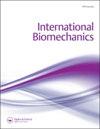预测的肌肉和膝盖接触力对肌肉补充标准公式中的归一化因子和多项式阶数的敏感程度如何?
Q2 Medicine
引用次数: 7
摘要
摘要肌肉骨骼建模是估计膝关节负荷的重要工具。在这些模型中,解剖肌肉经常被细分,以解释广泛的起源/插入区域。具体的细分已被证明会影响一些肌肉招募标准,并建议将标准化因素纳入模型中。本研究的主要目的是研究肌肉募集标准和多项式顺序中不同肌肉归一化因子对步态中估计的肌肉和膝关节总、内侧和外侧接触力的影响。这是在三种不同的肌肉骨骼模型上进行评估的,其中一个受试者的患者特异性和膝关节模型复杂性不断增加,来自Grand Challenge数据集,并根据测量的力进行评估。结果表明,肌肉归一化因子的引入影响了估计的力,并且当应用二阶多项式时,这种影响最为明显。此外,主要是第二接触力峰值受到影响。二次调查显示,预测的力可以作为膝屈肌和伸肌力量的函数而显著变化,预测的总压缩力的一个体重差异在力量的100%和40%之间。此外,发现步态期间预测的第二个峰值对模型中骨盆皮肤标记位置的位置敏感。这些结果表明,当引入归一化因子来解释细分肌肉时,尤其是对于二阶招募标准,应该谨慎。本文章由计算机程序翻译,如有差异,请以英文原文为准。
How sensitive are predicted muscle and knee contact forces to normalization factors and polynomial order in the muscle recruitment criterion formulation?
ABSTRACT Musculoskeletal modeling is an important tool to estimate knee loads. In these models, anatomical muscles are frequently sub-divided to account for wide origin/insertion areas. The specific sub-division has been shown to affect some muscle recruitment criteria and it has been suggested that normalization factors should be incorporated into models. The primary aim of this study was to investigate the effect of different muscle normalization factors in the muscle recruitment criterion and polynomial order on the estimated muscle and total, medial and lateral knee contact forces during gait. These were evaluated on three different musculoskeletal models with increasing levels of patient-specificity and knee joint model complexity for one subject from the Grand Challenge data set and evaluated against measured forces. The results showed that the introduction of the muscle normalization factors affected the estimated forces and that this effect was most pronounced when a polynomial of order two was applied. Additionally, mainly the second contact force peak was affected. Secondary investigations revealed that the predicted forces can vary substantially as a function of the knee flexor and extensor muscle strength with over one body weight difference in predicted total compressive force between 100% and 40% of the strength. Additionally, the predicted second peak during gait was found to be sensitive to the position of the pelvic skin marker positions in the model. These results imply that caution should be taken when a normalization factor is introduced to account for sub-divided muscles especially for second-order recruitment criteria.
求助全文
通过发布文献求助,成功后即可免费获取论文全文。
去求助
来源期刊

International Biomechanics
Medicine-Rehabilitation
CiteScore
1.90
自引率
0.00%
发文量
2
审稿时长
17 weeks
期刊介绍:
International Biomechanics is a fully Open Access biomechanics journal that aims to foster innovation, debate and collaboration across the full spectrum of biomechanics. We publish original articles, reviews, and short communications in all areas of biomechanics and welcome papers that explore: Bio-fluid mechanics, Continuum Biomechanics, Biotribology, Cellular Biomechanics, Mechanobiology, Mechano-transduction, Tissue Mechanics, Comparative Biomechanics and Functional Anatomy, Allometry, Animal locomotion in biomechanics, Gait analysis in biomechanics, Musculoskeletal and Orthopaedic Biomechanics, Cardiovascular Biomechanics, Plant Biomechanics, Injury Biomechanics, Impact Biomechanics, Sport and Exercise Biomechanics, Kinesiology, Rehabilitation in biomechanics, Quantitative Ergonomics, Human Factors engineering, Occupational Biomechanics, Developmental Biomechanics.
 求助内容:
求助内容: 应助结果提醒方式:
应助结果提醒方式:


